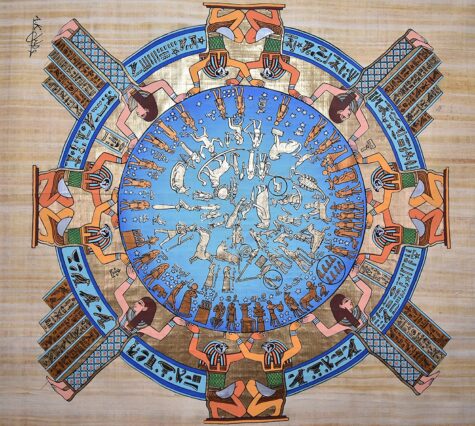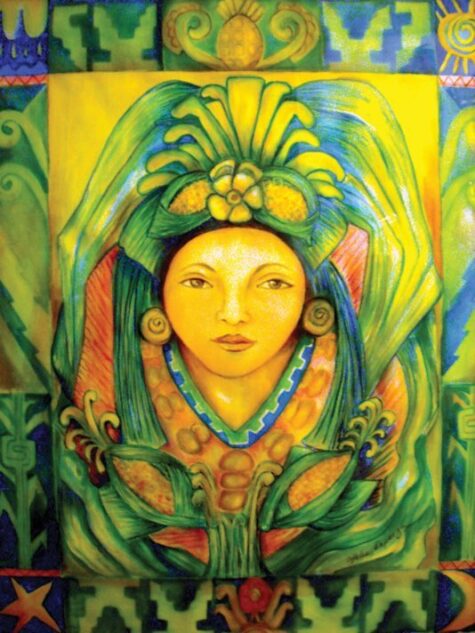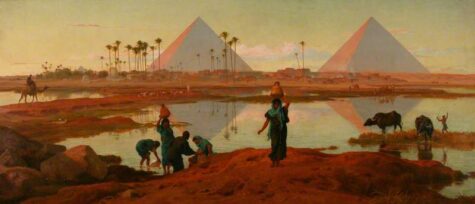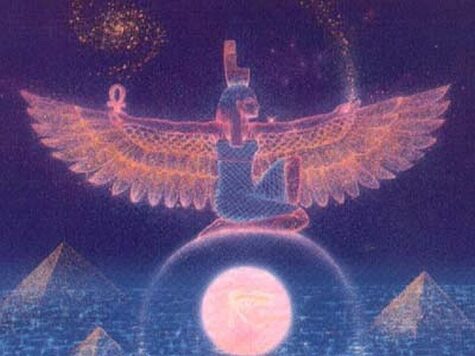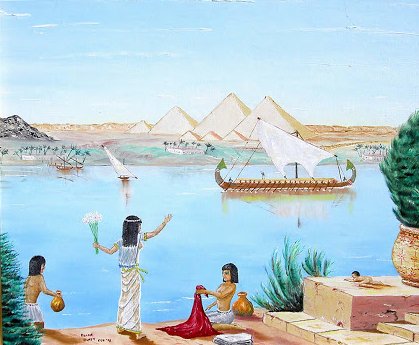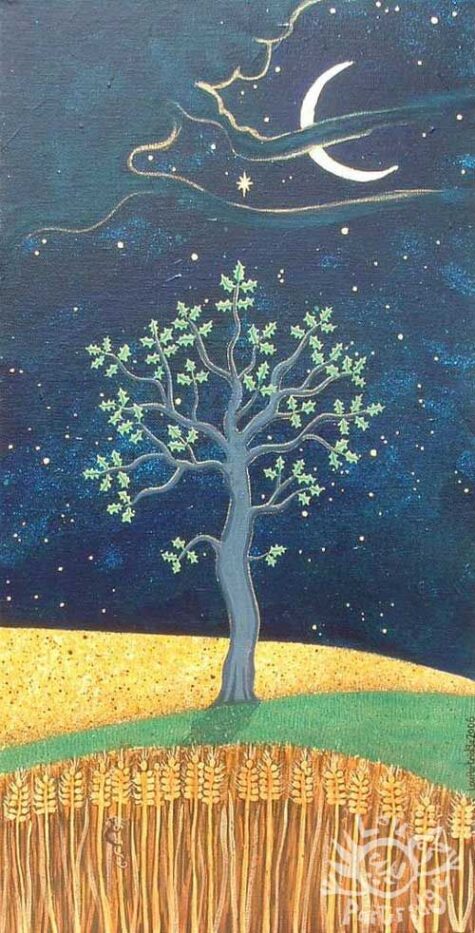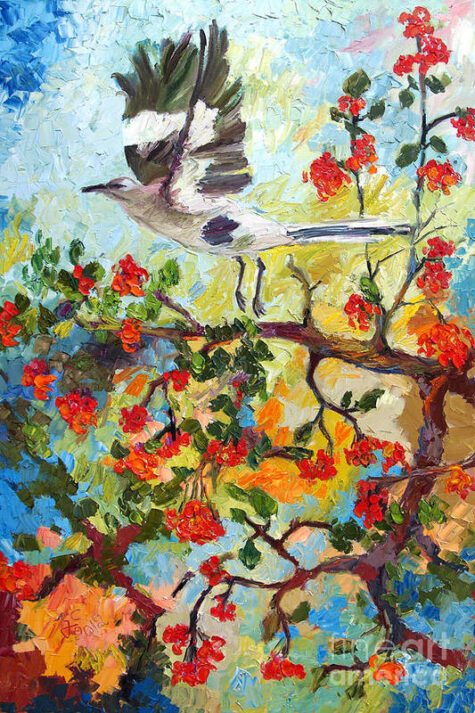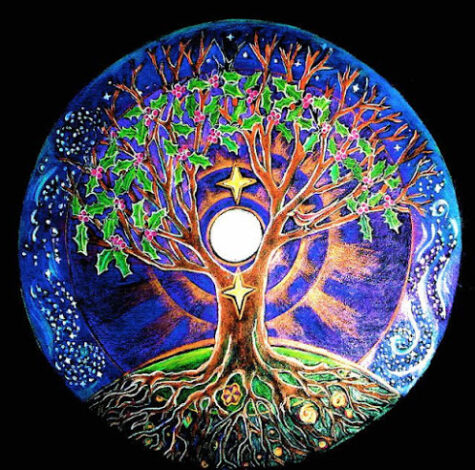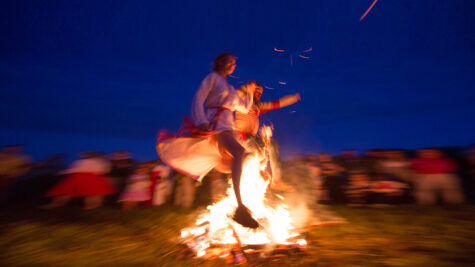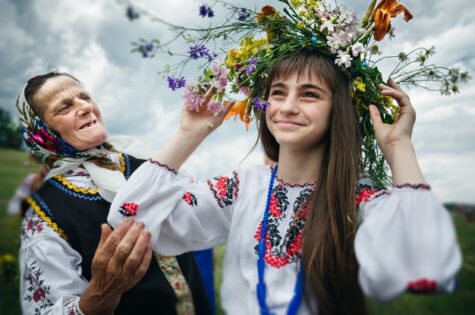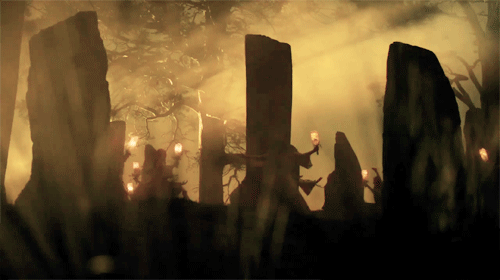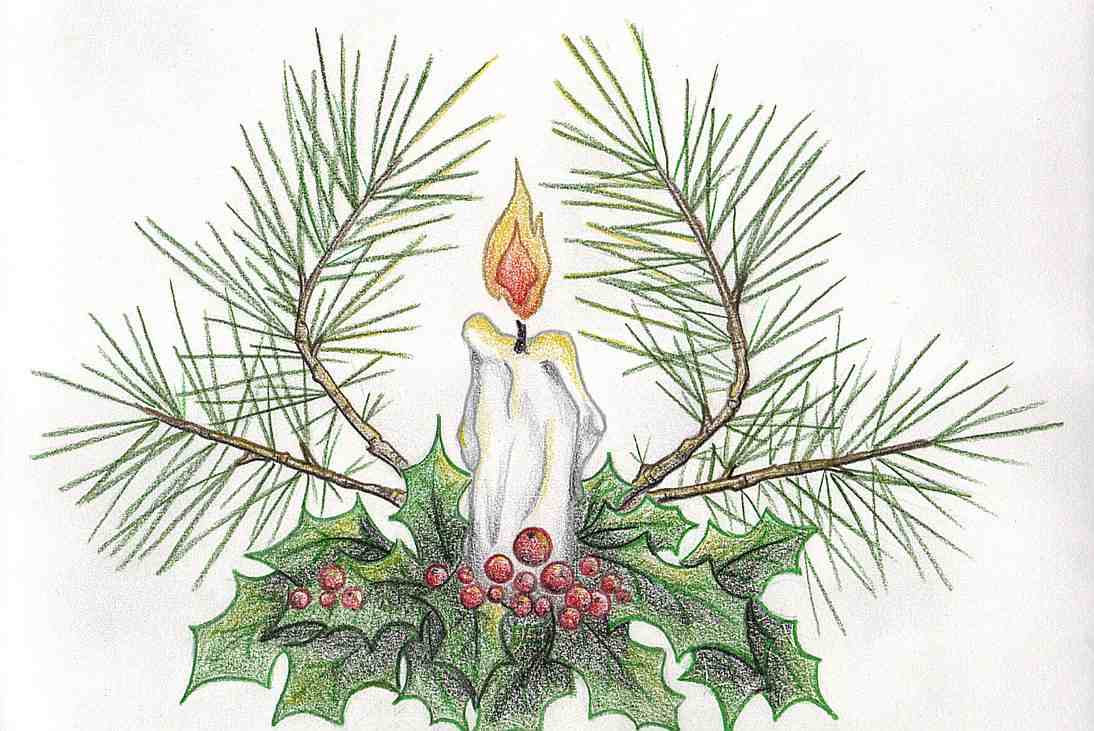Monthly Archives: July 2021
The 5 Epagomenal Days (6 during leap years) were inserted into the Egyptian Calendar which had been 360 days long. These days were reserved as birthdays for the gods. The first, third, and fifth of these days were considered unlucky by the Egyptians.
The legend behind the days holds the Nut had been forbidden to have children on any day of the year by her husband Geb. Thoth, upon hearing this, gambled with the moon-god for a fraction of his light. Thoth won and he created the additional 5 days for Nut so she could bear children on these days “not of the year.”
They are as follows:
- July 27 – 1st Epagomenal Day – Birthday of Osiris
- July 28 – 2nd Epagomenal Day – Birthday of Horus
- July 29 – 3rd Epagomenal Day – Birthday of Set
- July 30 – 4th Epagomenal Day – Birthday of Isis
- July 31 – 5th Epagomenal Day – Birthday of Nephthys
Note:
These dates come from Traci de Regulla in The Mysteries of Isis. She took her dating from Dr. Robert Brier’s Ancient Egyptian Magic. There is a great deal of dispute when it comes to calculating the dates of Egyptian festivals due to problems in their calendar system (it was only 360 days for some period of time).
The Green Corn Ceremony typically occurs in late July– early August, determined locally by the ripening of the corn crops. The ceremony is marked with dancing, feasting, fasting and religious observations.
The Green Corn Ceremony is a celebration of many types, representing new beginnings. Also referred to as the Great Peace Ceremony, it is a celebration of thanksgiving to Hsaketumese (The Breath Maker) for the first fruits of the harvest, and a New Year festival as well.
The Feast of Green Corn and Dance gives honor to Mantoo (Creator) provider of all things and celebrates our harvest, ancestors, elders, veterans, family and Native American heritage.
The Green Corn Ceremony is an annual ceremony practiced among various Native American peoples associated with the beginning of the yearly corn harvest.
These ceremonies have been documented ethnographically throughout the North American Eastern Woodlands and Southeastern tribes. Historically, it involved a first fruits rite in which the community would sacrifice the first of the green corn to ensure the rest of the crop would be successful.
These Green Corn festivals were practiced widely throughout southern North America by many tribes evidenced in the Mississippian people and throughout the Mississippian Ideological Interaction Sphere. Green Corn festivals are still held today by many different Southeastern Woodland tribes.
Literally the spirit of the corn in Native American traditions, Corn Mother brings with her the bounty of earth, its healing capabilities, it’s nurturing nature, and its providence.
- Symbols: Corn; Corn Sheaves
- Themes: Abundance; Children; Energy; Fertility; Harvest; Health; Grounding; Providence; Strength
This is the season when Corn Mother really shines, beautiful with the harvest. She is happy to share of this bounty and give all those who seek her an appreciation of self, a healthy dose of practicality, and a measure of good common sense.
To Do Today:
Around this time of year the Seminole Indians (in the Florida area) dance the green corn dance to welcome the crop and ensure ongoing fertility in the fields and tribe. This also marks the beginning of the Seminole year. So, if you enjoy dancing, grab a partner and dance? Or, perhaps do some dance aerobics. As you do, breathe deeply and release your stress into Corn Mother’s keeping. she will turn it into something positive, just as the land takes waste and makes it into beauty.
Using corn in rituals and spells is perfectly fitting for this occasion. Scatter cornmeal around the sacred space to mark your magic circle, or scatter it to the wind so Corn Mother can bring fertility back to you. Keeping a dried ear of corn in the house invokes Corn Mother’s protection and luck, consuming corn internalizes her blessings.
The traditional Ceremony:
The Busk or Green Corn Ceremony is the celebration of the New Year, so at this time all offenses are forgiven except for rape and murder, which are executable or banishable offenses.
In modern tribal towns and Stomp Dance societies only the ceremonial fire, the cook fires and certain other ceremonial objects will be replaced. Everyone usually begins gathering by the weekend prior to the ceremony, working, praying, dancing and fasting off and on until the big day.
The whole festival tends to last seven-eight days, if you include the historical preparation involved (without the preparation, it lasts about four days).
- Day One
The first day of the ceremony, people set up their campsites on one of the square ceremonial grounds. Following this, there is a feast of the remains of last year’s crop, after which all the men of the community begin fasting (historically, the women were considered too weak to participate). That night there is a social stomp dance, unique to the Muscogee and Southeastern cultures.
- Day Two
Before dawn on the second day, four brush-covered arbors are set up on the edges of the ceremonial grounds, one in each of the sacred directions.
For the first dance of the day, the women of the community participate in a Ribbon or Ladies Dance, which involves fastening rattles and shells to their legs perform a purifying dance with special ribbon-clad sticks to prepare the ceremonial ground for the renewal ceremony.
The ceremonial fire is set in the middle of four logs laid crosswise, so as to point to the four directions. The Mico (head priest) takes out a little of each of the new crops (not just corn, but beans, squash, wild plants, and others) rubbed with bear oil, and it is offered together with some meat as “first-fruits” and an atonement for all sins.
The fire (which has been re-lit and nurtured with a special medicine by the Mico) will be kept alive until the following year’s Green Corn Ceremony. In traditional times, the women would sweep out their cook-fires and the rest of their homes and collect the filth from this, as well as any old clothing and furniture to be burnt and replaced with new items for the new year.
The women then bring the coals of the fire into their homes, to rekindle their home fires. They can then bake the new fruits of the year over this fire (also to be eaten with bear oil). Many Creeks also practice the sapi or ceremonial scratches, a type of bloodletting in the mid morning, and in many tribes the men and women might rub corn milk, ash, white clay, or analogous mixtures over themselves and bathe as a form of purification.
They also drink a medicine referred to as the “White Drink.” (English traders referred to it as the “Black Drink” due to its dark liquid which froths white when shaken before drinking).
This White Drink, known to strangers as Carolina Tea, is a caffeine-laden mixture of seven to fourteen different herbs, the main ingredient being assi-luputski, Creek for “small leaves” of Yaupon Holly.
This medicine was intended to help receive purification, as it is a purgative when consumed in mass amounts. (Historically, only men drank enough of the liquid to throw up.) The purgative was consumed to clean the dietary tract of last year’s crop and to truly renew oneself for the new year.
- Day Three
While the second day tends to focus on the women’s dance, the third is focused on the men’s. After the purification of the second day, men of the community perform the Feather Dance to heal the community.
The fasting usually ends by supper-time after the word is given by the women that the food is prepared, at which time the men march in single-file formation down to a body of water, typically a flowing creek or river for a ceremonial dip in the water and private men’s meeting. They then return to the ceremonial square and perform a single Stomp Dance before retiring to their home camps for a feast.
During this time, the participants in the medicine rites are not allowed to sleep, as part of their fast. At midnight a Stomp Dance ceremony is held, which includes feasting and continues on through the night. This ceremony usually ends shortly after dawn.
- Day Four
The fourth day has friendship dances at dawn, games, and people later pack up and return home with their feelings of purification and forgiveness. Fasting from alcohol, sexual activity, and open water will continue for another four days.
More Information
Puskita, commonly referred to as the “Green Corn Ceremony” or “Busk,” is the central and most festive holiday of the traditional Muscogee people. It represents not only the renewal of the annual cycle, but of the spirit and traditions of the Muscogee. This is representative of the return of summer, the ripening of the new corn, and the common Native American traditions of environmental and agricultural renewal.
Historically in the Seminole tribe, 12-year-old boys are declared men at the Green Corn Ceremony, and given new names by the chief as a mark of their maturity.
Several tribes still participate in these ceremonies each year, but tribes who have historic tradition within the ceremony include the Iroquois, Cherokee, Creek, Choctaw, and Seminole tribes. Each of these tribes may have their own variations of celebration, dances and traditions, but each performs a new-year’s ceremony involving fasting and several other comparisons each year.
Sources:
July 19 was a very important date in ancient Egyptian Cosmology. Known as ‘The Opening of the Year,” or the “Sothic New Year,” it was celebrated with a festival known as “The Coming of Sopdet.”
The oldest festival in ancient Egyptian history, the celebration of The Opening of the New Year began with the rising of Sirius who appeared as the goddess Isis cloaked in robes of brilliant light.
The sky is serene. Sothis lives. She shines, a peaceful flame.
Unas lives eternal as the son of Sothis,
As the child of Isis, as a child of Light,
As Earth is child of the Cosmos.
Unas is pure. She is pure,
As are all the gods whoever lived since the beginning of time
In the worlds above and in the worlds below.
They have been born the Imperishable Stars
Living within the Meshetiu, which shall never die.
~Pyramid Text Utterance 302
Sirius forms a part of the constellation Canis Major, sometimes referred to as the Dog Star. Of all the stars in the sky throughout the year, Sirius shines the brightest. The Greeks called the star Sothis, meaning “The Soul of Isis”. The Egyptians called her Sept or Sopdet, referring to the concept of preparing for the future. The ancient feast day name Per Sopdet may be translated as T”he Coming Forth of the Goddess.”
On this day Sirius, the “Dog Star”, rose together with Sun and announced the annual flooding of Nile River. The lands were watered and a black layer of slime covered them, providing humidity and fertilizer for next year’s harvest: the nation would not suffer of hunger. Thus it was the first year of the mystical Egyptian year, symbolizing transmutation and fertility.
Note: The actual date of this event in ancient Egypt is different than the current date because the date slowly varies within the Gregorian calendar, owing to its omission of three leap years every four centuries. It presently occurs on 3 August.
Ancient Egyptian Rites and Festivities
When Sirius reappeared as the morning star, the altars at the Isis temples of Philae, Karnak, and Dendera opened early. The portals and sanctuaries were aligned so precisely with the heavenly bodies that the predawn starlight of Sirius was projected onto the cult statue of the goddess. Thus began a season of preparation for the coming agricultural year and a celebration of the flood and fecundity of earth.
New Year’s Day in every temple across the land began with the lighting of the wicks for the temple fires. The glowing lamplight symbolized the eternal life of the spirit world and the flame’s earthly burning became a mirrored image of the glittering light of Sothis in the sky.
The lifting of the fires was usually followed by an offering of bread and prayers glorifying the dead, enacted in the northern corner of the temple – the northern region being linked with the souls of the ancestors, the Imperishable Ones who were the circumpolar stars.
When the Opening of the year or Wept Renpet was celebrated, it was also a day to celebrate the traditional birthday of the king and later the Pharoah – no matter the true date of his birth. The New Year’s Feast was an important festival in the life of the Egyptian ruler. It involved his ritually hoeing the ground and breaking the dirt clods in preparation for the sowing that would follow the receding waters.
The water stands and fails not, and the Nile carries a high flood. The days are long, the nights have hours, and the months come aright. The Gods are content and happy of heart, and life is spent in laughter and wonder.
~Prayer from the Sallier Papyrus
The galleries inside the pyramids point to the heavenly position of Sirius on such a day. Sirius was both the most important star of ancient Egyptian astronomy, and one of the Decans. Decans are star groups into which the night sky was divided, with each group appearing for ten days annually. The first night that Sirius is seen, just before dawn (heliacal rising) was noticed every year during July, and the Egyptians used this to mark the start of the New Year.
In fact, the “Sothic Rising” only coincided with the solar year once every 1460 years. The Roman emperor Antoninus Pius had a commemorative coin made to mark their coincidence in AD 139. The Sothic Cycle (the periods between the rising of the star) have been used by archaeologists trying to construct a chronology of Ancient Egypt.
About Sopdet
Sirius was named Sothis by Egyptians and from archaic ages it symbolized eternity and fertility. As early as the 1st Dynasty, she was known as ‘the bringer of the new year and the Nile flood. Sopdet took on the aspects of a goddess of not only the star and of the inundation, but of the fertility that came to the land of Egypt with the flood. The flood and the rising of Sirius also marked the ancient Egyptian New Year, and so she also was thought of as a goddess of the New Year.
- Themes: Fertility, Destiny, Time
- Symbols: Stars and Dogs.
Not just a goddess of the waters of the inundation, Sopdet had another link with water – she was believed to cleanse the pharaoh in the afterlife. It is interesting to note that the embalming of the dead took seventy days – the same amount of time that Sirius was not seen in the sky, before it’s yearly rising. She was a goddess of fertility to both the living and the dead.
In the Pyramid Texts, she is the goddess who prepares yearly sustenance for the pharaoh, ‘in this her name of “Year”‘. She is also thought to be a guide in the afterlife for the pharaoh, letting him fly into the sky to join the gods, showing him ‘goodly roads’ in the Field of Reeds and helping him become one of the imperishable stars. She was thought to be living on the horizon, encircled by the Duat.
The reigning Egyptian Queen of the Constellations, Sopdet lives in Sirius, guiding the heavens and thereby human destiny. Sopdet is the foundation around which the Egyptian calendar system revolved, Her star’s appearance heralding the beginning of the fertile season. Some scholars believe that the Star card of the Tarot is fashioned after this Goddess and Her attributes.
The long, hot days of summer are known as the ‘Dog Days‘ because they coincide with the rising of the dog star, Sirius. In ancient Egypt this was a welcome time as the Nile rose, bringing enriching water to the land.
Activities for Today
Go outside tonight and see if you can find Sirius. When you spy it, whisper a wish to Sopdet suited to Her attributes and your needs. For example, if you need to be more timely or meet a deadline, she’s the perfect Goddess to keep things on track.
If you’re curious about your destiny, watch that region of the sky and see if any shooting stars appear. If so, this is a message from Sopdet. A star moving on your right side is a positive omen; better days are ahead. Those on the left indicate the need for caution, and those straight ahead mean things will continue on an even keel for now. Nonetheless, seeing any shooting star means Sopdet has received your wish.”
- Recall a new beginning
Recall a time in your life when you were starting anew, perhaps after a divorce or when moving into a new home. Perhaps your new life followed the birth of a child or a change in career. Investigate what had to die in your old life in order for the new life to emerge. How did that feel as you stood poised on the brink of change?
- Explore your creativity
Explore what it means to be creative. Think about the most creative times in your life. Where did you live? How different did life seem then from the way it seems now? How was your time structured? What were you thinking, desiring, telling yourself on a daily basis? Can you duplicate any of that in your life now?
- Ten Things
Make a list right now of ten things you want to manifest in the next six months. Be specific. Plant three seeds for each thing you want to manifest, then tend to them. Mark each seed with a popsicle stick to indicate what goal you are germinating, so that when you water the plant, you stay focused on what you are nurturing within yourself.
Write a brief prayer to one of the abundance goddesses – Isis, Hathor, or Anket – asking her to guide you and oversee your fecundity. Say your prayer each time you tend your plants.
Sources:
- Tour Egypt
- Journeying To The Goddess
- Feasts of Light
The eighth Celtic Moon month sees in the start of the waning of the days. The power of the Sun is transferred to the Earth, highlighting our practical needs and desires. The Celtic fire festival of Lammas begins the harvest on 1st August. Thus, the month of the Holly Moon is a time to give thanks for what you have and to appreciate the good things in your life. Focus on your own ‘harvest’ during the month of Holly – on what you wish to achieve and why.
- Dates: July 8 – August 4
- Celtic Name: Tinne
- Language of Flowers: Foresight
- Qualities: Strength, Protection, Vitality, Life Force, Old Age, Dormancy, Healing
- Themes: Immortality, Rebirth, Masculine Energy, Protection, Strength, Safety.
Traditionally the first grain harvested was baked into a loaf that represented the spirit of the crop, or ‘John Barleycorn’ as it is called in England. This bread was then shared in a ceremony to ensure the wealth of the entire community.
This month is a time to celebrate your successes with family and friends and to consider sharing your good fortunes with others. Use the energetic blessings of the Holly Moon to celebrate and share the good things in your life and to increase your future fortune and success.
The spirit of renewal in the month of the Holly Moon makes it an excellent time to re-energize your life.
- Tune into the energies of your environment by eating energy-rich seasonal foods, preferably foods that are produced locally.
- Use Holly’s influence to rise to physical challenges and overhaul your personal fitness by joining a gym or taking up martial arts.
The Holly takes over the Oak when it starts to fall. This evergreen plant reminds us all year long about the immortality of nature. The Holly moon was called Tinne, pronounced chihnn-uh, by the Celts, who knew the potent Holly was a symbol of masculine energy and firmness.
The planetary ruler of Holly is Mars, which bestows upon the tree certain qualities. The ability to restore direction in your life. To re-balance and align energy. And, to help you achieve a sense of purpose.
In pagan tradition, men carry sachets of Holly leaves and berries, which will enhance their masculinity due to the trees restorative and energizing powers.
Holly the Ruler
The noble one among the Celtic tree astrology signs is the Holly. Those born under this sign are natural leaders and easily acquire power and higher status. They can effortlessly tackle the hardest tasks and often possess rare skills and tact. The Holly is always set to reach its goal and can be too competitive and ambitious at times.
This tree sign brims with confidence, kindness and passion. However, if it doesn’t lead and active lifestyle, the Holly can become too lazy. Ash and Elder signs can form a good partnership with the noble Holly sign.
Holly Magick and Lore
The Holly is a tree of strength and protection. It’s a tree that contains a vital life force to take us through the darkest days with light, colour, and tenacity. It’s a tree of foresight, wisdom and healing, of age and rebirth.
It’s a symbol of nature – the ‘wildman’ (and perhaps woman) in all of us – linking midsummer to midwinter – and linking our darkest hours to our times of plenty, giving us life and strength to carry on.
The Holly King is the god or guardian of the darker part of the year, while the Oak King is the god or guardian of the lighter part of the year…
But the switch-over was marked at the solstices – so the Oak King guards the waxing year of fecundity (from midwinter to midsummer) – and hands over the mantel at midsummer to the Holly King who guards the waning year (midsummer to midwinter) – the period of harvest, the dying days of the year and dormancy.
This is why we see the Holly tree, which we normally associate with midwinter festivities, celebrated in the very middle of summer, as the solstice is marked as a turning point in the year – the fulcrum point where the natural world starts to wane and die, ready to re-emerge again at the winter solstice.
The ancients used the wood of the Holly in the construction of weapons, but also in protective magick. Hang a sprig of Holly in your house to ensure good luck and safety to your family. Wear as a charm, or make Holly Water by soaking leaves overnight in spring water under a full moon — then use the water as a blessing to sprinkle on people or around the house for protection and cleansing.
The Holly tree is also known as the tree of sacrifice. It’s symbolic of sacrifice, unconditional love, and reincarnation. Holly serves to remind us to control our emotions and remain calm during periods of decision-making. Likewise we must also remain calm and accept responsibility for our actions; even when such acceptance comes with consequences. More importantly, the Holly encourages us to love ourselves, as well as others, in the light of compassion and unconditional love.
The wood of the Holly was used to make spears due to it’s firmness after being dried. Holly berries were used in spellwork for female fertility and sexuality – they symbolize the blood of the life-giving Goddess.
The power of the Holly was seen to be in its life force – its living energy, so strong and vibrant in midwinter. This led to Druids advising people to bring the green foliage inside to decorate their homes and bring that life force inside.
The main symbolic importance of Holly is in its evergreen nature – in the darkest midwinter days, the Holly stays shiny and green and is even lit up with brilliant red berries – the hardy leaves withstanding even the harshest winter weathers. The glossy leaves of the Holly also reflected all available light around home and made those darkest days of winter a little lighter and brighter, lifting the mood of the inhabitants of the home.
It was also thought that the foliage would provide shelter to the elves and fairies who could live safely side by side with humans at this special time – with the caveat that the Holly foliage should be removed by Imbolc Eve (31st January).
Holly Money Energy
On the full Moon hold up a note of money to the moonlight and recite the words:
“Lady bright, lade bright,
harvest abundant dreams tonight.
Three times three times three times three,
prosperity return to me.”
Give the money to charity and in return the positive energy of Holly will provide you with the funds you need in the coming months.
Sources:
Kupala Night and Ivan Kupala Day is celebrated in Ukraine, Poland, Belarus and Russia from the night of July 6 to the day of July 7 on the Gregorian calendar. This corresponds to June 23 to 24 on the traditional Julian calendar.
The celebration is linked with the summer solstice when nights are the shortest and includes a number of Slavic rituals. This holiday symbolizes the birth of the summer sun – Kupalo.
In the fourth century AD, this day was Christianized and proclaimed the holiday of the birth of John the Baptist. As a result, the pagan feast day “Kupala” was connected with the Christian “Ivan” (Russian for John) which is why the Ukrainian, Belarusian and Russian name of this holiday combines “Ivan” and Kupala which is derived from the Slavic word for bathing.
The two feasts could be connected by reinterpreting John’s baptizing people through full immersion in water. However, the tradition of Kupala predates Christianity. The pagan celebration was adapted and reestablished as one of the native Christian traditions intertwined with local folklore.
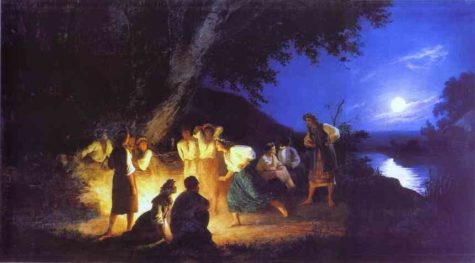
And Then It Was Banned
In the XVIII century, there were a number of documents testifying to the fierce struggle of the Church and secular authorities with the Kupala rite.
For example, in 1719 Hetman of Zaporizhzhia Army, Chairman of the Cossack state of the left bank of Ukraine, Ivan Skoropadskyi issued a decree “On parties, fisticuffs, gatherings on the holiday of Ivan Kupala etc.”, which granted the right to physically punish (tie up and beat with sticks) and excommunicate from the Church all participants of Kupala games.
In 1723, Przemysl Cathedral in Bereziv banned dancing and entertainment near the Kupala fire. In 1769, Catherine II issued a decree banning the holiday. And despite all the prohibitions, the pagan nature of folk rituals was strong. The church did not ban the holiday, but it did try to fill it with Christian content.
It is the pagan essence, mysticism, marriage-erotic motifs of Kupala rite that attracted the attention of many researchers and artists. Thanks to public ritual such art masterpieces as the Opera “Ivana Kupala” by S. Pysarevskyi; folklore work of L. Ukrainka “Kupala in Volyn”; the story of M. Gogol “Night of Ivan Kupala”; the film of Yurii Ilienko “Night on Ivan Kupala”; the Folk Opera of Y. Sankovych “When the fern blooms.” The latter during 40 years was banned and only in 2017 its world premiere took place on the stage of the Lviv Opera.
Kupala Today
At the beginning of the twentieth century Kupala rite gradually began to disappear. Today it exists in the “revived”, or rather “introduced” in Soviet times (during the anti-religious struggle) form of staged ceremony.
Although the magical meaning of rituals was leveled, and the celebration gained artistic value, the main pagan ritual actions have reached us – weaving of wreaths by girls and letting them into the water; honoring Kupala tree with dances; kindling the fire and jumping over the fire; ritual bathing; burning or sinking of trees; the burning of sacks of straw or stuffed dolls; the ceremonial dinner.
It is interesting that the name of the holiday, and the ritual fire, and decorated tree are called “Kupalo”, “Kupailo” or “Kupailytsia”. These are also the main elements of the rituals, which are based on the cult of fire, water and vegetation. Rituals symbolize the union of male (fire) and feminine (water) elements, were carried out with the aim of ensuring productivity, health, procreation.
On the territory of Ukraine for many centuries Kupala customs changed and they were not everywhere equally preserved. The majority were saved in Polissia as one of the more archaic zones of the Slavic world.
The holiday is still enthusiastically celebrated by the younger people of Eastern Europe. The night preceding the holiday (Tvorila night) is considered the night for “good humor” mischiefs (which sometimes would raise the concern of law enforcement agencies).
On Ivan Kupala day itself, children engage in water fights and perform pranks, mostly involving pouring water over people. Many of the rites related to this holiday are connected with the role of water in fertility and ritual purification.
According to ancient traditions, Ivan Kupala is the festival of the sun, and the most important role in mystical rites belongs to the power of fire. Our ancestors believed that the fire is the sun-embryo in the womb. Therefore, in the Kupala night taken to jump over the fire.
On Kupala day, young people jump over the flames of bonfires in a ritual test of bravery and faith. First, the oldest of the young men jumped over the fire.
For the highest jumpers it predicted a good harvest and prosperity for his family. Then pairs would jump, traditionally it would be a boy and a girl, but I assume that in some areas it’s permissible for pairs of any kind to take the jump together. If the couple is successful in their jump over the fire – they will certainly marry. The failure of a couple in love to complete the jump, while holding hands, is a sign of their destined separation. And anyone entering the flames during their jump can expect trouble
On the evening of July 6, unmarried girls take wreaths they have woven and throw them into the water. Unmarried men then try to grab the one belonging to the girl they are interested in. If you snag a wreath, the girl who made it will be expected to kiss you and the two of you will be paired up for the evening.
Girls may also float wreaths of flowers (often lit with candles) on rivers, in an attempt to gain foresight into their romantic relationships based from the flow patterns of the flowers on the river.
When the fun subsides, many people light candles from the hearth on pre-prepared wreath baskets and go to the river to put them on the water and thus honor their ancestors.
There is an ancient Kupala belief that the eve of Ivan Kupala is the only time of the year when ferns bloom. Prosperity, luck, discernment, and power befall whom ever finds a fern flower. Therefore, on that night, village folk roam through the forests in search of magical herbs, and especially, the elusive fern flower.
Traditionally, unmarried women, signified by the garlands in their hair, are the first to enter the forest. They are followed by young men. Therefore, the quest to find herbs and the fern flower may lead to the blooming of relationships between pairs within the forest.
It is to be noted, however, that ferns are not angiosperms (flowering plants), and instead reproduce by spores; they cannot flower.
In Gogol’s story The Eve of Ivan Kupala a young man finds the fantastical fern-flower, but is cursed by it. Gogol’s tale may have been the stimulus for Modest Mussorgsky to compose his tone poem Night on Bald Mountain, adapted by Yuri Ilyenko into a film of the same name.
Sources:
There is a lot to celebrate in July. This is a list of pretty much everything that goes on during the seventh month of the year. Many of these dates change from year to year. The days that change are marked with this » symbol.
July Lore and General Info

Astronomical Events
- July 3 thru August 11: Dog Days of Summer
- July 10 » New Moon
- July 12 thru August 23: Delta Aquarids Meteor Shower
- July 17 thru August 24: Perseids Meteor Shower
- July 24 » Full Moon – Buck Moon
Astrological Events
Depending on which astrological system you adhere to, these are the signs that show up in July of 2021. Be aware that some of these dates will vary from year to year. Unlike the Sun signs which might just shift by 1 or 2 days, the dates of the various Moon signs will vary widely from year to year. The same holds true for the Chinese Zodiac. The Celtic Tree Signs are based on an arbitrary system and stay the same from year to year.
Western Astrology
The July Sun begins in Cancer and finishes up in Leo:
- Jun 21 thru Jul 22 » Sun in Cancer
- Jul 22 thru Aug 22 » Sun in Leo
The moon cycles through the signs as follows:
- Jun 1 – Jul 3 » Moon in Aries
- Jul 3 – Jul 6 » Moon in Taurus
- Jul 6 – Jul 8 » Moon in Gemini
- Jul 8 – Jul 11 » Moon in Cancer
- Jul 11 – Jul 13 » Moon in Leo
- Jul 13 – Jul 15 » Moon in Virgo
- Jul 15 – Jul 17 » Moon in Libra
- Jul 17 – Jul 19 » Moon in Scorpio
- Jul 19 – Jul 21 » Moon in Sagittarius
- Jul 21 – Jul 24 » Moon in Capricorn
- Jul 24 – Jul 26 » Moon in Aquarius
- Jul 26 – Jul 28 » Moon in Pisces
- Jul 28 – Jul 30 » Moon in Aries
- Jul 30 – Aug 2 » Moon in Taurus
You will notice that the Moon might begin the day in one sign and by the end of the day may have moved into another sign, so timing matters if you are wanting to be precise.
The Celtic Tree Signs in July:
- Oak: Jun 10 – Jul 7
- Holly: Jul 8 – Aug 4
The Alternative Celtic Zodiac is as follows:
- Apple: Jun 22 – Jul 2
- Fir: Jul 3 – Jul 13
- Elm: Jul 14 – Jul 24
- Cypress: Jul 25 – Aug 4
The Chinese Calendar and Zodiac
We are currently in the year of the Ox (sometimes referred to as the Cow). Each Month is also assigned a specific animal. Here’s what shows up in July 2021.
- Horse: Jun 5 – Jul 6 (Chinese Zodiac – Stem Branch Calendar)
- Horse: Jun 10 – Jul 9 (Lunar Calendar – 5th Lunar Month)
- Sheep: Jul 7 – Aug 6 (Chinese Zodiac – Stem Branch Calendar)
- Sheep: Jul 10 – Aug 7 (Lunar Calendar – 6th Month)
Note: The traditional Chinese Astrology birth chart is built by the Chinese Stem Branch Calendar, not the Chinese Lunar Calendar, which I think is really confusing. Because of a difference in time zones, the lunar months will have different pattern between China and the USA.

Lucky and Unlucky Days
You might want to plan moving, traveling, major purchases, court dates, and weddings around these dates, avoiding the unlucky days and utilizing the lucky ones.
- These are the lucky days in July:
9, 15 and 28. - These are the unlucky days in July:
3, 10, 17, 18 and 21.
Fatal Days
The thirteenth is a fatal day,
The tenth alike will mortals slay.
Holidays and Holy Days
Many of the holidays begin on the eve of the night before and end on the eve of the day of. It’s also important to remember that the dates of archaic festivals and feast days may vary widely depending on the source.
July 1
- 1: Canada Day
July 2
- 2: Feast of Expectant Mothers
- 2: World UFO Day (sometimes celebrated on June 24)
July 3
July 4
- 4: Independence Day
- 4 » Dakini Day (Tibetan)
July 5
- 5: Poplifugia
- 5 » Day of Ekadashi (Hindu)
- 5 thru 21: Naadam Festival
July 7
- 7: Festival of the Handmaidens – Nonae Caprotinae (“the nones of the wild fig”)
- 7: Festival for the Pales (also on Apr 21)
- 7: Tanabata – The Star Festival (Japan)
- 7: Rumilia Festival – see also Poplifugia
July 9
July 10
- 10: Day of Hel
- 10: Festival of Knut the Reaper
- 10: Lady Godiva Day
July 11
- 11 » The Noumenia
July 12
July 13
- 13 thru 15: OBon Festival – see also Aug 13 – 15
July 14
- 14: Bastille Day
July 15
- 15: Day of Rauni
July 16
- 16: World Snake Day
July 18
- 18: Day of Bad Omens – Black Day (Also Oct 6)
July 19
- 19 » Umi no Hi – Marine Day
- 19: Lucaria
- 19 and 20 » Eid al-Adha
July 20
- 20 » Day of Ekadashi (Hindu)
July 23
- 23: Neptunalia – the festival of Neptune, the Roman god of the sea.
- 23 thru Aug 1 » Boryeong Mud Festival
July 24
- 24 » Asalha Puja Day
- 24: Pioneer Day
July 25
- 25: Plant A Turnip Seed Today
- 25: A Day Out of Time
- 25: Furinalia
- 25: Day of Aegir and Ran
July 27
- 27 thru 31: The Five Epagomenal Days
- 27: Birthday of Osiris
July 28
- 28: Birthday of Horus
July 29
- 29: Birthday of Set
- 29: Honoring The Thunder God
- 29: Stikklestad Day – Honors the Asatru martyrs who died rather then submit to gray slavery.
July 30
- 30: Birthday of Isis
July 31
- 31: Birthday of Nephthys

Saint Days
There is a surprising amount of magick associated with Saint days. This is a very short list of the Saint days in July, there are many many more. As time goes by I may end up listing them all, but for now, this is what I have.
- 11: St Benedict Day
- 15: St. Swithin’s Day
- 15: St. Vladimir the Great Day
- 16: Feast of Our Lady of Carmel
- 22: Feast of Mary Magdalene
- 23: Saint Anne’s Eve
- 25: St. James the Great Day
- 26: Feast of St Anne

Recipes For July
Many more seasonal recipes, including recipes for new and full moon ceremonies, ancient Greek and Roman holy days, Asian festivals and etc can be found here: Seasonal Recipes.
![]()
Notes:
Any July lore, almanac, astrological, and celebration dates that have been shared after this post was published can be found by searching the July posts to see what’s new.
A lot of work went into this post which was compiled from various sources by Shirley Twofeathers for The Pagan Calendar. You may repost and share without karmic repercussions, but only if you give me credit and a link back to this website. Blessed be.
